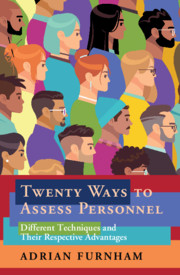Book contents
- Twenty Ways to Assess Personnel
- Twenty Ways to Assess Personnel
- Copyright page
- Dedication
- Contents
- Tables
- Preface
- Acknowledgements
- 1 Introduction to Selection and Assessment
- 2 Complex and Sticky Issues in Assessment and Selection
- 3 Traditional and Mainly Discredited Assessment Methods
- 4 Self-Report Tests
- 5 Observer Reports
- 6 Behavioural Tests
- 7 Physiology
- 8 Biography
- 9 Big Data
- 10 The Future of Assessment
- Index
- References
9 - Big Data
Published online by Cambridge University Press: 11 June 2021
- Twenty Ways to Assess Personnel
- Twenty Ways to Assess Personnel
- Copyright page
- Dedication
- Contents
- Tables
- Preface
- Acknowledgements
- 1 Introduction to Selection and Assessment
- 2 Complex and Sticky Issues in Assessment and Selection
- 3 Traditional and Mainly Discredited Assessment Methods
- 4 Self-Report Tests
- 5 Observer Reports
- 6 Behavioural Tests
- 7 Physiology
- 8 Biography
- 9 Big Data
- 10 The Future of Assessment
- Index
- References
Summary
One of the biggest, newest and most exciting assessment and research opportunity to occur since the millennium has been the exploitation of Big Data, which is the ‘electronic footprint’ that we all leave when using credit and other cards as well as the web, through a variety of social networks. Assessment, selection and recruitment experts have not been slow in seeking Big Data as a way of collecting a wide variety of pieces of information about targeted individuals. There have also been some high-profile scandals using Big data. This chapter looks at the five Vs of Big data: Volume (how much data on individuals is potentially available), Variety (the wide range of data on behaviours available), Velocity (the sheer speed of data accumulation and possibilities of analysis), Veracity (the all-important point of the accuracy and truthfulness of the data) and Value (whether it is uniquely valuable or not). Studies on Facebook profiles are discussed in detail. It is perhaps the most exciting prospect for person assessment, but the promises, perils and problems are also discussed. Finally, half a dozen experts report on how they see Big Data as offering opportunities for person assessment.
Keywords
- Type
- Chapter
- Information
- Twenty Ways to Assess PersonnelDifferent Techniques and their Respective Advantages, pp. 474 - 505Publisher: Cambridge University PressPrint publication year: 2021



